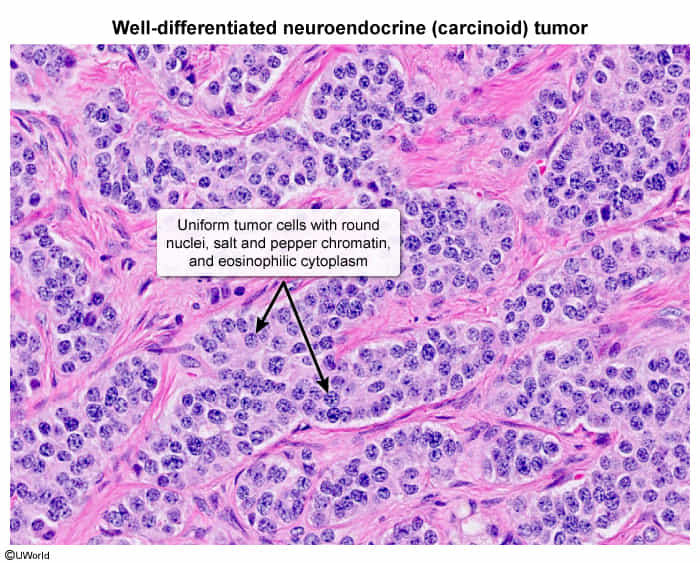Epidemiology
Etiology
Pathophysiology
Overview
- Carcinoid tumors are neuroendocrine tumors that arise from amine precursor uptake and decarboxylation cells (APUD cells).
- A group of endocrine cells that secrete peptide hormones (e.g., secretin, cholecystokinin)
- These cells take up amine precursors (e.g., 5-hydroxytryptophan) and decarboxylate them to form amines.
- Neuroendocrine cells (including β cells in the pancreas or enterochromaffin cells in the GI tract) belong to the APUD series and share a common biologic function despite their different embryologic origins, anatomic sites, and secretory products (e.g., serotonin, histamine).
Tumor location
- GI tract (55% of cases):
- Small intestine (esp. the ileum): 45%
- Rectum: 20%
- Appendix: 17%
- Pancreas (15% of cases)
- Insulinoma
- Glucagonoma
- Bronchopulmonary system (10% of cases)
- Carcinoid lung tumor
- Small cell carcinoma
- Thyroid: medullary carcinoma
- Adrenal glands: pheochromocytoma
Secretory products
- Carcinoid tumors can synthesize different hormones (most commonly serotonin).
- Serotonin is degraded via the following mechanisms:
- First-pass metabolism in the liver
- Monoamine oxidases in the lung
- Serotonin can reach systemic circulation under the following conditions:
- Intestinal carcinoid tumors with liver metastases
- Extraintestinal carcinoid tumors
- ↑ Serotonin in systemic circulation can lead to:
- Carcinoid syndrome
- Carcinoid heart disease
- Pellagra due to increased serotonin metabolism
Clinical features
- Carcinoid syndrome
- Diarrhea and abdominal cramps
- Cutaneous flushing
- Caused by vasodilation of small arteries and arterioles
- Possible triggers: alcohol consumption, food intake, stress
- In severe cases, may be accompanied by tachycardia and fluctuating blood pressure
- Dyspnea, wheezing (asthma-like attacks)
- Palpitations
- Possible weight loss despite normal appetite
- Carcinoid heart disease
- Liver metastases of the carcinoid tumor produce serotonin which travels to the right heart via the IVC.
- Endocardial fibrosis that especially affects the right heart
- Tricuspid insufficiency and/or pulmonary stenosis
- Symptoms of right-sided heart failure
- Other symptoms: abdominal pain
Tip
In a patient presenting with secretory diarrhea, episodic flushing, wheezing, and cardiac valvular abnormalities, consider a carcinoid tumor.
Diagnostics
- ↑ 5-hydroxyindoleacetic acid (5-HIAA) in 24-hour urine collection
- A degradation product of serotonin metabolism. Elevated levels in 24-hour urine are seen in carcinoid tumor.
Biopsy
- Histology
- Can show a variety of architectural patterns (e.g., islands, nests, trabeculae)
- Prominent rosettes composed of numerous small monomorphic cells with salt-and-pepper chromatin


- Immunohistochemistry: immunostaining with synaptophysin, chromogranin A, and neuron-specific enolase (NSE) to confirm neuroendocrine origin
Treatment
- Somatostatin analogs (e.g., octreotide) to relieve symptoms
- ↓ 5-HIAA levels in the urine
- High-dose treatment slows progression and increases survival time
- Tryptophan hydroxylase inhibitors (e.g., telotristat) as adjunctive therapy if diarrhea is not controlled with somatostatin analogs
- rate-limiting step of serotonin synthesis